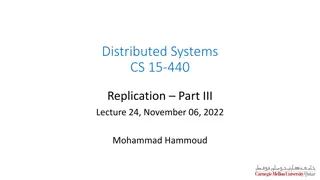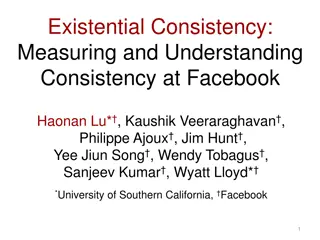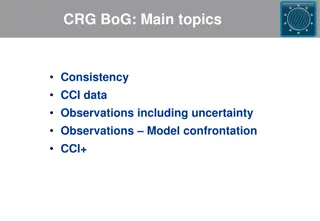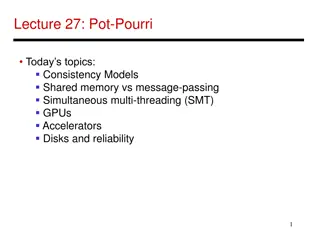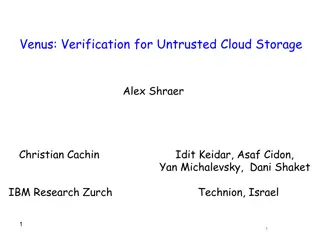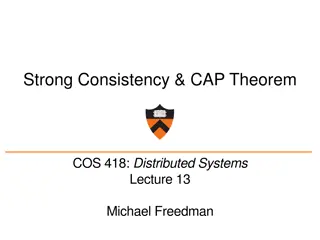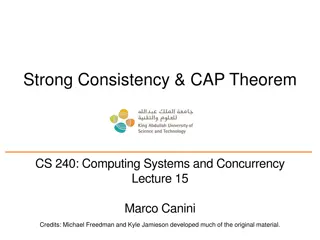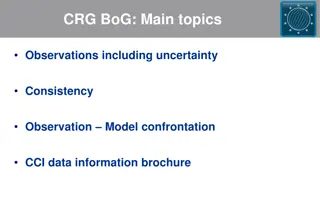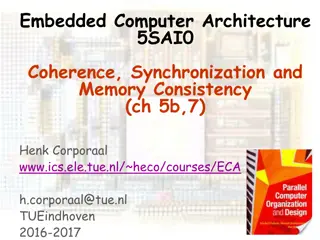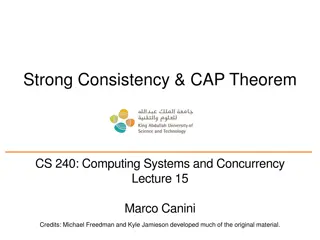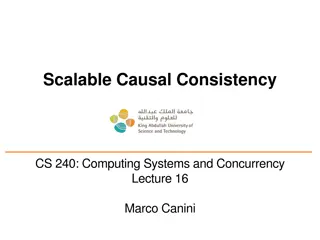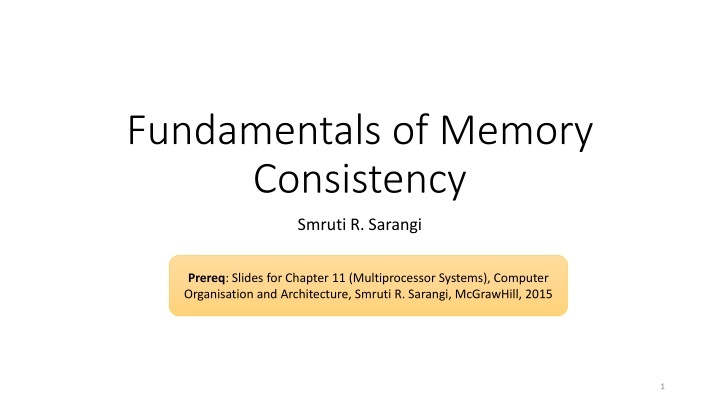
Memory Consistency in Multiprocessor Systems
Explore the fundamentals of memory consistency in multiprocessor systems, covering topics like sequential consistency, operational vs. axiomatic models, terminology, and well-formedness conditions. Gain insights into program order, relaxations, coherence, and more.
Download Presentation

Please find below an Image/Link to download the presentation.
The content on the website is provided AS IS for your information and personal use only. It may not be sold, licensed, or shared on other websites without obtaining consent from the author. If you encounter any issues during the download, it is possible that the publisher has removed the file from their server.
You are allowed to download the files provided on this website for personal or commercial use, subject to the condition that they are used lawfully. All files are the property of their respective owners.
The content on the website is provided AS IS for your information and personal use only. It may not be sold, licensed, or shared on other websites without obtaining consent from the author.
E N D
Presentation Transcript
Fundamentals of Memory Consistency Smruti R. Sarangi Prereq: Slides for Chapter 11 (Multiprocessor Systems), Computer Organisation and Architecture, Smruti R. Sarangi, McGrawHill, 2015 1
Contents Basic Terminology Program Order Relaxations Healthiness Conditions 2
Sequential Consistency Leslie Lamport s definition The result of any execution is the same as if the operations of all the processors were executed in some sequential order, and the operations of each individual processor appear in this sequence in the order specified by its program. SC is intuitive SC is slow Weak memory models can reorder insructions Weak models enable many processor optimizations 3
Operational vs. Axiomatic Models Operational Model of SC P1 P2 Pn Pick one processor at a time Memory Axiomatic Model of SC Allowed Behaviors Disallowed behaviors 4
Terminology Global view A set of memory events that are totally ordered. All processors agree with the same total order. (recapitulate total ordering) Local view Order of memory events from the point of view of one processor only. Other processors might not agree with this view. A memory request, m, has the following properties loc(m) its location val(m) its value proc(m) its processor Ml memory events to location, l Rl Reads to l Wl Writes to l 5
Some more terminology If memory events (read/write/fence) p1 and p2 are in the same thread, we define the program order relationship p1 p2, or alternatively (p1, p2) po p1 needs to complete its execution before p2 Weak memory models need not respect the program order Let us define the read-from relationship: w r, or alternatively (w,r) wr r reads from w Wx2 means: write 2 to location x Rx1 means: read 1 from location x po rf 6
Well formedness conditions In the rf relationship A read reads its data from only one write Let us define a function: wf-rf (rf) It is true if the relationship, rf, is well formed Meaning: A read gets its data from only one write Let us now add some coherence conditions Every location has a globally visible order of writes Let us call this the coherence order ws = union of coherence orders for all locations ws is well formed (wf-ws(ws) = true) Meaning: The coherence order is well defined for all memory locations 7
From-read map (fr) Execution Witness P0 P1 Wx2 rf, po (a) x = 1 (b) x = 2 (c) r1 = x Rx2 ws r1=2, x = 1 fr Wx1 fr Consider the example: Rx2 needs to execute before Wx1 If not it will read 1, instead of 2 There is clearly an order between Rx2 and Wx1 It is called the fr(from-read) order Formal definition of fr ?.(w,r) rf (w,w ) ws fr (r,w ) 8
Relationships between memory accesses ws coherence (write write, same loc) rf write read, dependence (same loc) fr read write, dependence (same location) po program order 9
Global happens before (ghb) Given the relationships between instructions Can we define a global order of memory accesses If (m1,m2) ghb (m1 precedes m2 in the global order) THEN forall processors p, (m1,m2) lhbp lhbp is the local happens before order for processor, p In the global order (for almost all memory models): ws is a part of ghb fr is a part of ghb rf (maybe not) 10
Let us divide rf into two parts rf rfe rfi (w,r) rf proc(w) = proc(r) (w,r) rf proc(w) proc(r) rf across processors rf same processor grf = rf ghb rf relations that are part of the global order 11
Execution Witness Local vs Global Order (d) Wy1 rfi fr P0 P1 reads/writes Core (e) Ry1 (c) Ry0 (a) x = 1 (b) r1 = x (c) r2 = y (d) y = 1 (e) r3=y (f) r4 = x po po (f) Rx0 (b) Rx1 reads write buffer r1 = 1, r2= 0, r3 = 1, r4 = 0 fr rfi (a) Wx1 L1 writes The global order cannot have a cycle This means that rfi is not global if we respect po The local order of P0 contains Wx1 Rx1, but does not contain Wy1 Ry1 and vice-versa The local order can be different from the global order 12
Contents Basic Terminology Program Order Relaxations Healthiness Conditions 13
Program Order Types of memory instructions Read Write Fence All memory models respect Read Fence, Fence Read, Write Fence, Fence Write The order between Reads and Writes to different addresses might or might not be ensured. 14
location not updated atomically with write buffers Summary of Memory Models W R W W R RW Relaxation Read other s write early Read own write early SC TSO (Intel) Processor consistency PSO Weak Ordering IBM PowerPC ARM Ordering that is relaxed Let the program order relationships that are guaranteed to be preserved by a memory model be ppo 15 ppo po
Putting it All Together ? ? = ??? ?? ?? ??? The global order respects a part of the program order (ppo) Coherence (ws) read write order for the same location (fr) and some write read orders (grf) If, rfe ??? This means that stores are not atomic. Different processors see stores to happen at different times. read others writes early falls in this category If, rfi ??? This means that we have some way of reading the value of writes inside a processor before the write is visible to everybody else. Possible in processors with load-store forwarding, and write buffers. read own writes early falls in this category. 16
Deeper look at the global order ? ? = ??? ?? ?? ??? always need to hold Only the ppo and the grf can be changed by memory models ws and fr are fundamentally properties of coherence. They always need to hold. Any memory model is defined by: ppo and grf All global orders have to be acyclic You can never have a cycle in a happens before relationship For a memory model to be sound The global order being acyclic is only one condition We will see more later ... 17
Examples: Load-load or Store-store reordering Execution Witness P0 P1 (a) Wx1 po (a) x = 1 (b) y = 1 (c) r3 = y (d) r4 = x (b) Wy1 rfe fr r3 = 1, r4 = 0 (c) Ry1 po (d) Rx0 To allow this outcome either load-load or store-store does not hold IBM PowerPC and ARM allow this behavior How can this happen? ANS: Messages get reordered in the NoC 18
Example: Load Store reordering Execution Witness P0 P1 (a) Rx1 po (a) r1 = x (b) y = 1 (c) r2 = y (d) x = 1 (b) Wy1 rfe rfe r1 = r2 = 1 (c) Ry1 po (d) Wx1 The load store reordering must cease to hold here IBM and ARM allow this (message reordering in the NoC) 19
Example: Store atomicity relaxation (rfe) Execution Witness (c) Ry2 rfe P0 P1 P2 P3 po (d) Rx0 (f) Wy2 (a) r1 = x (b) r3 = y (c) r2 = y (d) r4 = x (e) x = 1 (f) y = 2 fr fr (e) Wx1 (b) Ry0 r1 = 1, r3 = 0, r2 = 2, r4 =0 po rfe (a) Rx1 If we assume that the read-read ordering is a part of ppo (like Intel TSO) The only way this can happen if rfe is not global How can this happen? Assume P3 and P1 share a cache bank. P1 has a mechanism to read the new cache contents in this bank before (P0,P2) can read it. Same with P0 and P2. 20
Contents Basic Terminology Program Order Relaxations Healthiness Conditions 21
Healthiness Conditions We have up till now talked only about multiprocessors What about uniprocessors? ANS: All the programs running on uniprocessors should have the same output irrespective of the memory model. How do we formalize this? ?1,?2? ????? ?1,?2? ?? ??? ?1= ??? ?2 Uniprocessor Condition uniproc(E, rf, ws) ???????( ?? ?? ?? ?????) 22
What does the uniproc Condition Mean? For a single processor: Consider an execution, E Create a graph of events with the following relations rf data dependence via memory ws coherence write order fr (read write) order for the same memory location poloc program order for memory accesses to the same memory location Create a graph: Should be acyclic Alternatively this condition also guarantees per location, SC holds All memory models need to obey the uniproc criterion also 23
Example: Invalid executions as per uniproc Execution Witness P0 P1 (a) Wx1 rfe (a) x = 1 (b) r1 = x (c) x = 2 (b) Rx1 ws po_loc x = 1, r1 = 1 (c) Wx2 24
Example 2: Invalid executions as per uniproc Execution Witness P0 P1 (c) Rx1 po_loc fr (a) x = 1 (b) r1 = x (c) r2 = x (d) x = 2 (b) Rx2 (d) Wx2 rfe r1 = 2, r2 = 1, x = 2 po_loc ws (a) Wx1 25
Thin Air Reads Execution Witness P0 P1 (c) Ry1 (a) r1 = x r9 = r1 XOR r1 (b) y = 1 + r9 (c) r4 = y r9 = r4 xor r4 (d) x = 1 + r9 rfe dp (b) Wy1 (d) Wx1 r1 = 1, r4 = 1 dp rfe (a) Rx1 Let us add a new kind of edge: dp (data dependence) One thing is for certain: You cannot write to y before reading x AND you cannot write to x before reading y This should be forbidden because r1 and r4 actually seen either 0, or a junk value How can this happen? Ans: If you predict the load values for r1 and r4 (result of aggressive speculation, compiler opts) 26
Formalizing the Thin Air Read Constraint ? ?? ?,??,?? ??????? (?? ?? ? ) rf represents data dependences across processors dp data dependences in the same core Data dependences cannot form a cycle, also means you cannot read junk data as valid 27
When is an execution valid? ????? ?,??,?? = ???? ?? ???? ?? ? ?? ?,??,?? ??????? ?,??,?? ???????(? ? ?,??,?? ) When is an execution valid under a memory model? rf and ws are well formed No thin air reads Uniprocessor constraints need to be met No cycles in the global happens before relationship 28


